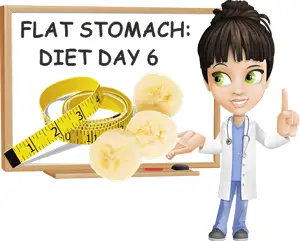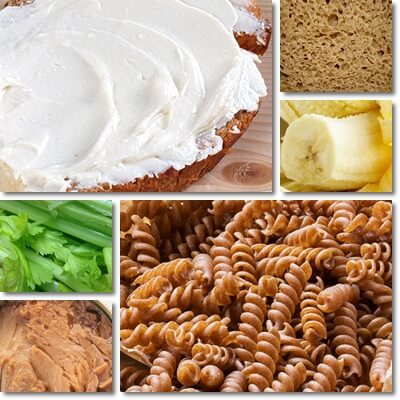A flat stomach diet is just another weight loss diet. But before you get disappointed that there’s no quick fix to losing belly fat, know that it’s possible to be on a diet and lose excess weight to show off your flat stomach and thin waist and still eat delicious food every single day. And because weight loss is 80% dieting, it’s good that there’s so much variety to enjoy even in low calorie weight loss meal plans.
My flat stomach diet is varied, focused on clean food and balanced in macronutrients so that you don’t go hungry and feel both satiated and mentally satisfied with what you’re eating, and all the while lose excess weight. Each day you’ll get to eat all kinds of different foods, including simple carbs and fruits like bananas that are normally banned in a diet.

The secret is in eating small amounts of food at a time and pairing the different classes of foods so that you get all of your macronutrients (carbs, protein and fats) in the same meal.
Macronutrient balance is what brings about satiety and prevents cravings conducive to binge eating and diet failure.
The meal plan I’m proposing is also focused on unprocessed foods and foods that are nutritionally dense to help you get as much of your daily intake of vitamins and minerals as possible. It’s easier to be on a diet when you get to eat differently and can also have foods that are not allowed in most diets.
Check out my day 1 flat stomach diet plan, day 2, day 3, day 4 and day 5 and get inspired for day 6 below.
Do know that substitutions are permitted to account for intolerances, food sensitivities or allergies, but keep to recommended amounts, measure and count calories if you’re going for different options. It’s easy for just one apparently low-calorie meal to provide 1000+ calories and ruin your diet.

Breakfast: ricotta cheese on toast with banana
- Ingredients: 80 grams of plain, white bread or whole grain (about 2 big slices), 100 grams light ricotta cheese, 1 medium banana (estimated weight: 110 grams)
- Calories (average values): 200 kcal (kilocalories, calories) from the bread, 115 kcal from the ricotta cheese, 99 kcal from the banana for a total of 414 kcal
- Fruit options: If bananas are just not for you, you can go for pears (200 grams – 120 kcal), strawberries (200 grams – 70 kcal), red, yellow or purple raspberries (200 grams – 110 kcal), sweet cherries (200 grams – 125 kcal), peaches or nectarines (200 grams – 80 kcal) or apricots (200 grams – 95 kcal)
The bread accounts for the carbohydrate part of the meal and you can choose either plain white bread or whole grain. Whole grain is better because it’s high in fiber to help with satiety, but white is filling too. The banana also accounts for the carbohydrate part of the diet, but is a source of natural sugars to satisfy sweet cravings, but in a healthy way.
The ricotta cheese is a classic Italian cheese, minimally processed and nutritious. It accounts for both the protein and fat part of the diet and rounds up the macronutrient profile of the meal to help keep you satiated and mentally satisfied. If ricotta is not available, know you can substitute it with a light cottage cheese from fresh milk.
What are the benefits?
The carbs in the bread are meant to provide both quick and long-lasting energy to start the day right. The banana is sweet for a boost in disposition and has simple sugars for a boost in energy. The good content of magnesium and potassium in bananas (roughly 8% of daily values) is a source of important benefits for blood pressure. Bananas have good amounts of vitamin C for anti-inflammatory and immune-boosting benefits and vitamin B6 for energy metabolism, and help combat fatigue.
Ricotta cheese is a fresh whey cheese, healthy and minimally processed. Because it’s light, that means it has less fat (just 5 grams or so), but more protein (11+ grams of protein) and more water soluble vitamins and minerals. Ricotta is good for the heart, muscles and nervous system, supports energy metabolism and cognitive functions for a boost in productivity and better mood.
Lunch: spelt wheat fusilli with tomatoes, tuna and Parmesan
- Ingredients: 80 grams spelt wheat fusilli pasta, 100 grams skipjack tuna brined in water (drained solids), 150 grams fresh or canned tomatoes, 20 grams Parmesan cheese
- Other ingredients: fresh parsley for flavor, salt and ground pepper
- Calories (average values): 156 kcal (kilocalories) from the spelt wheat fusilli, 90 kcal from the tuna, 30 kcal from the tomatoes, 80 kcal from Parmesan cheese for a total of 356 kcal
The spelt wheat fusilli (or other pasta shape) accounts of the carbohydrate part of the meal and is a low-calorie option, great for a weight loss diet. However, do know that it’s not gluten-free. The tuna and Parmesan cheese provide both protein and fat. The tomatoes have small amounts of carbs, sugar and fiber, but mostly bring flavor.
How to make the dish
Salt and bring a pot of water to boil, then cook the pasta according to the recommended time. In a separate pan, add the fresh or canned tomatoes, tuna, drained, and water and cook for 10-15 minutes. Once cooked, season with salt, ground pepper and fresh parsley. Drain the pasta and mix in with the sauce. Plate and grate 20 grams of Parmesan cheese on top.
What are the benefits?
Spelt wheat is a nutritious option, although unsuitable for anyone with gluten sensitivity or intolerance (e.g. Celiac disease sufferers). It’s high in fiber and starch with prebiotic benefits and nourishes good gut bacteria for bowel health. Not just this, but spelt is satiating and helps curb hunger while providing the mental satisfaction of eating carbs. It further provides decent amounts of protein to the diet and good amounts of minerals with benefits for the immune system, bone density and iron and B vitamins for energy metabolism.
Tuna is nutritionally dense and one of the few foods that naturally have vitamin D. The content of vitamin D in tuna is good enough for it to contribute substantially to daily values and provide benefits for the immune system, bones and teeth and thyroid health. Tuna is also high in protein with benefits for muscles, supports cognitive functions and combats anemia and fatigue. See more benefits of eating tuna.
Tomatoes and parsley add flavor and contribute to daily vitamin and minerals values, albeit modestly. You do get good amounts of lycopene from red tomatoes, and potassium, with benefits for high blood pressure. Yellow tomatoes provide lutein and zeaxanthin which are good for vision and lower cataract risks. Or you can go for black tomatoes with scientifically proven anticancer properties.
Snack:
- Option no. 1: brewed coffee with 200 ml (milliliters) of low fat 1.5% daily milk or a plant milk of your choice for an afternoon pick-me-up (just 90 kcal)
- Option no. 2: 230 grams of seasonal yellow cherries, red or black cherries (just 150 kcal)
- Option no. 3: 25 grams of dark chocolate (150 kcal)
- Option no. 4: 1 tablespoon (25 grams) of peanut butter, almond butter or pistachio butter (approximately 150 kcal)
A snack is just as important for curbing hunger as it is for curbing cravings. While you do need to limit the number of calories and go for healthy options, do eat things you like. Just make sure you stay within a reasonable intake (or number of calories) as this is not a main meal.
Dinner: celery with beans dish, bread
- Ingredients: 100 grams celery stalks, 40 grams onion, 1 tablespoon of olive oil, 200 white cannellini beans (white kidney beans), drained, 50 grams bread
- Other ingredients: salt, ground pepper, fresh parsley, fresh lovage, dill, other spices and herbs you may like
- Calories (average values): 16 kcal from the celery, 16 kcal from the onion, 124 kcal from the olive oil, 184 kcal from the beans, 125 kcal from the bread for a total of 465 kcal
How to make the dish
Wash and chop the celery stalks and the onion. In a pan, add one tablespoon of olive oil and fry the chopped onion until golden. Add the chopped celery stalks and one glass of water and cook until the desired texture. If you like the celery to stay crunchy, cook for just 10-15 minutes over medium heat; if you like it softer, cook for 20 minutes or more. Add water as needed. Drain and rinse the beans and add to the pan and heat. Season with salt, ground pepper, fresh parsley or lovage and enjoy.
What are the benefits?
The beans are the main nutritious element of the meal and provide good amounts of protein for satiation (12.5 t0 21 grams of protein per 200 grams of beans).
They are also an important source of dietary fiber which further contributes to satiation and curbing hunger, and represents a source of prebiotic benefits for bowel health.
Beans are high in vitamin B9 and have anti-anemia benefits and benefits for energy metabolism, providing long-lasting energy. You get 40% to 50% of your entire daily iron values from just 200 grams of canned kidney beans for a boost in vitality and energy levels. Not just this, but beans are high in minerals for good bone density and teeth health.
High in magnesium and potassium, beans help lower blood pressure numbers and are conducive to restful sleep as a result of their anti-hypertensive benefits. Zinc and protein support the immune system function.
Both celery and onion have scientifically proven anticancer effects. The celery, onion and bread contribute to the carbohydrate part of the meal and help curb cravings conducive to overeating. The olive oil represents the fat part of the meal and is rich in healthy fats with cardioprotective benefits and benefits for skin health and brain health.
